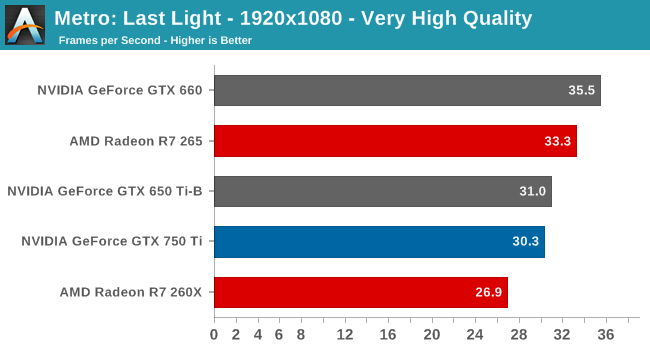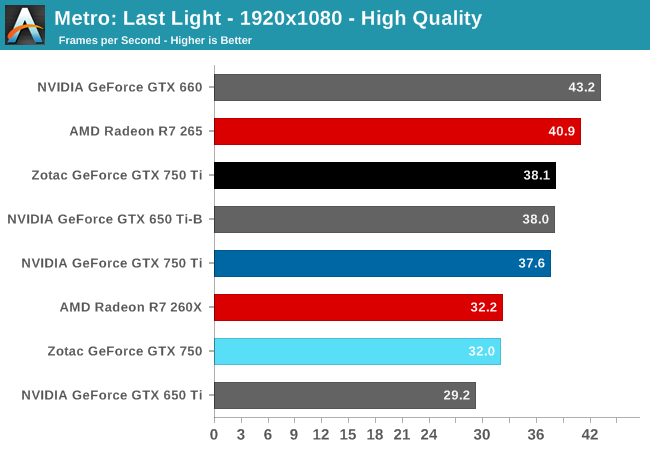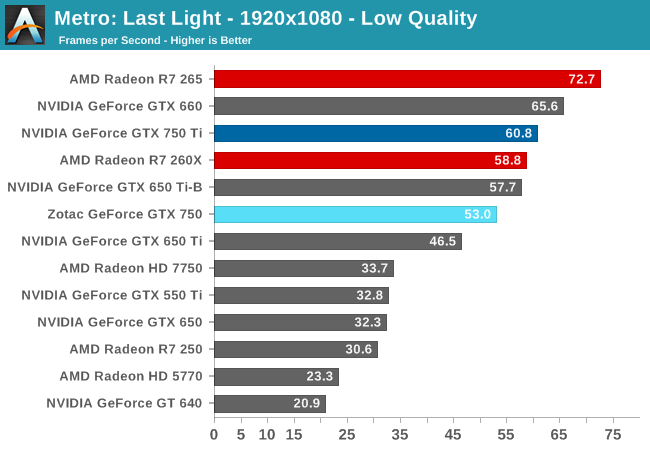The NVIDIA GeForce GTX 750 Ti and GTX 750 Review: Maxwell Makes Its Move
by Ryan Smith & Ganesh T S on February 18, 2014 9:00 AM ESTMetro: Last Light
As always, kicking off our look at performance is 4A Games’ latest entry in their Metro series of subterranean shooters, Metro: Last Light. The original Metro: 2033 was a graphically punishing game for its time and Metro: Last Light is in its own right too. On the other hand it scales well with resolution and quality settings, so it’s still playable on lower end hardware.



Diving into our performance analysis, we’ll be looking at a few different factors. On a competitive basis, the GTX 660 and the R7 265 are the GTX 750 Ti’s closest competitors. Though we’ll also want to compare it to GTX 650, so see what a GK107 versus GM107 matchup looks like. Meanwhile the GTX 750’s closest competitors will be the R7 260X, and to a lesser degree the GTX 650 Ti.
Being one of our more difficult games, Metro shows right off the bat that these mainstream video cards, no matter how fast they are, will face a difficult time. The GTX 750 Ti can stay comfortably above the 30fps at high quality, but the GTX 750 not so much.
What’s clear right off the bat two is two things. The first is that GTX 750 Ti, the GM107 flagship, is significantly faster than GTX 650, the GK107 flagship. GTX 750 Ti is just short of doubling GTX 650’s performance in this benchmark.
The second point is that neither GTX 750 series card is going to fare well against its AMD counterpart. Both the R7 265 and R7 260 are faster than the GeForce cards, and by over 10% at times.
Finally, GTX 750 Ti won’t be touching GTX 660 here. It’s close, but especially at higher quality settings the GTX 660 is pulling away. GTX 750 Ti can’t completely make up for the lack of memory bandwidth and ROP throughput.










177 Comments
View All Comments
kwrzesien - Tuesday, February 18, 2014 - link
Seems coincidental that Apple is going to use TSMC for all production of the A8 chip with Samsung not ready yet, maybe Apple is getting priority on 20nm? Frankly what nVidia is doing with 28nm is amazing, and if the yields are great on this mature process maybe the price isn't so bad on a big die. Also keep in mind the larger the die the more surface area there is to dissipate heat, Haswell proved that moving to a very dense and small die can create even more thermal limitations.DanNeely - Tuesday, February 18, 2014 - link
Wouldn't surprise me if they are; all the fab companies other than Intel are wailing about the agonizingly high costs of new process transitions and Apple has a history of throwing huge piles of its money into accelerating the build up of supplier production lines in trade for initial access to the output.dylan522p - Tuesday, February 18, 2014 - link
Many rumors point to Apple actually making a huge deal with intel for 14nm on the A8.Mondozai - Wednesday, February 19, 2014 - link
Maybe 14 for the iPhone to get even better power consumption and 20 for the iPad? Or maybe give 14 nm to the premium models of the iPad over the mini to differentiate further and slow/reverse cannibalization.Stargrazer - Tuesday, February 18, 2014 - link
So, what about Unified Virtual Memory?That was supposed to be a major new feature of Maxwell, right? Is it not implemented in the 750s (yet - waiting for drivers?), or is there currently a lack of information about it?
A5 - Tuesday, February 18, 2014 - link
That seems to be a CUDA-focused feature, so they probably aren't talking about it for the 750. I'm guessing it'll come up when the higher-end parts come out.Ryan Smith - Thursday, February 20, 2014 - link
Bingo. This is purely a consumer product; the roadmaps we show are from NV's professional lineup, simply because NV doesn't produce a similar roadmap for their graphics lineup (despite the shared architecture).dragonsqrrl - Tuesday, February 18, 2014 - link
"Meet The Reference GTX 750 Ti & Zotac GTX 750 Series""This is the cooler style that most partners will mimic, as the 60W TDP of the GTX 650 Ti does not require a particularly large cooler"
You mean 750 Ti right?
chizow - Tuesday, February 18, 2014 - link
The performance and efficiency of this chip and Maxwell is nothing short of spectacular given this is still on 28nm. Can't wait to see the rest of the 20nm stack.Ryan, are you going to replace the "Architectural Analysis" at some point? Really looking forward to your deep-dive on that, or is it coming at a later date with the bigger chips?
dgingeri - Tuesday, February 18, 2014 - link
In the conclusion, the writer talks about the advantages of the AMD cards, but after my experiences with my old 4870X2, I'd rather stick with Nvidia, and I know I'm not alone. Has AMD improved their driver quality to a decent level yet?